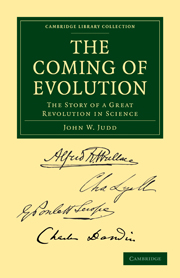Book contents
- Frontmatter
- Contents
- CHAP. I Introductory
- CHAP. II Origin of the Idea of Evolution
- CHAP. III The Development of the Idea of Evolution to the Inorganic World
- CHAP. IV The Triumph of Catastrophism over Evolution
- CHAP. V The Revolt Scrope and Lyell against Catastrophism
- CHAP. VI The Principles of Geology
- CHAP. VII The Influence of Lyell's Works
- CHAP. VIII Early Attempts to establish the Doctrine of Evolution for the Organic World
- CHAP. IX Darwin and Wallace: The Theory of Natural Selection
- CHAP. X The Origin of Species
- CHAP. XI The Influence of Drawin's Works
- CHAP. XII The Place of Lyell and Darwin in History
- Notes
- Index
- Plate section
CHAP. III - The Development of the Idea of Evolution to the Inorganic World
Published online by Cambridge University Press: 07 September 2010
- Frontmatter
- Contents
- CHAP. I Introductory
- CHAP. II Origin of the Idea of Evolution
- CHAP. III The Development of the Idea of Evolution to the Inorganic World
- CHAP. IV The Triumph of Catastrophism over Evolution
- CHAP. V The Revolt Scrope and Lyell against Catastrophism
- CHAP. VI The Principles of Geology
- CHAP. VII The Influence of Lyell's Works
- CHAP. VIII Early Attempts to establish the Doctrine of Evolution for the Organic World
- CHAP. IX Darwin and Wallace: The Theory of Natural Selection
- CHAP. X The Origin of Species
- CHAP. XI The Influence of Drawin's Works
- CHAP. XII The Place of Lyell and Darwin in History
- Notes
- Index
- Plate section
Summary
We have seen in the preceding chapter that, with respect to the origin of plants and animals—including man himself—two very distinct lines of speculation have arisen; these two lines of thought may be expressed by the terms ‘manufacture’—literally making by hand, and ‘development’ or ‘evolution,’ —a gradual unfolding from simpler to more complex forms. Now with respect to the inorganic world two parallel hypotheses of ‘ creation’ have arisen, like those relating to organic nature ; but in the former case the determining factor in the choice of ideas has been, not the avocations of the primitive peoples, but the nature of their surroundings.
The dwellers in the valleys of the Euphrates and Tigris could not but be impressed by the great and destructive floods to which those regions were subject; and the inhabitants of the shores and islands of the Aegean Sea, and of the Italian peninsula, were equally conversant with the devastations wrought by volcanic outbursts and earthquake shocks. As great districts were seen to be depopulated by these catastrophies, might not some even more violent cataclysm of the same kind actually destroy all mankind, with the animals and plants, in the comparatively small area then known as ‘ the world’?
- Type
- Chapter
- Information
- The Coming of EvolutionThe Story of a Great Revolution in Science, pp. 14 - 19Publisher: Cambridge University PressPrint publication year: 2009First published in: 1910



